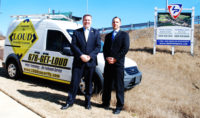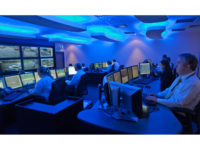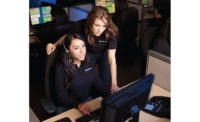Security dealers that use a third-party central station for monitoring have a lot riding on their relationship with that central station.
“They interact more with my subscribers than any of my current employees do,” observes John Loud, president of Kennesaw, Ga.-based security dealer LOUD Security Systems Inc.
Considering that LOUD Security has more than 9,000 customers (it is ranked No. 92 on the SDM 100), the company’s relationship with its central station is particularly critical. When the central station that LOUD Security had been using for eight years was acquired by another company, Loud and his management team had the sorts of concerns that any company would have when a critical supplier was acquired. Would service and programs remain at the level to which LOUD Security had become accustomed?
Loud and his team also made the decision to find out more about other third-party central stations and what they could offer, with an eye toward a possible change of suppliers.
SDM spoke with Loud and his team over a period of several months, checking in regularly with them as they conducted their research.
Evaluation Criteria
One of the first steps that Loud and his team made when they undertook their exploration was to create a list of criteria that they would use to evaluate each central station. Loud shared that list with us (see related article, “Loud Security’s Evaluation Criteria” on page 90), and it has dozens of items on it. As we talked to Loud and his general manager Eric Widner, though, it became clear that some of these items were what some people call “table stakes” — features that all central stations should have. But there were also a handful of criteria that differentiated one central station from another for LOUD Security.
Loud sums it up as follows: “If I’m going to pay over a million dollars over the next three years, I want a strategic partner that will help grow my business.”
As we talked to Loud and Widner about the seven central station visits that the company made, we noticed that certain criteria were top of mind with them. For example, Loud was particularly interested in central stations that offer dealers the opportunity to get together and learn from one another.
“All dealers should look to get strengthened by dealers from other parts of the country,” he says. The central station that LOUD Security had been using offered a dealer program and that was something Loud didn’t want to give up. He views dealer programs as an “R&D” opportunity. While this means “research and development” to most people, Loud has a different definition of the term: “ripoff and duplicate — learn from others in the industry.”
Loud also was especially interested in central stations that had a substantial number of accounts in LOUD Security’s home state because LOUD might at some point be interested in talking with the dealers owning those accounts about acquiring them.
On the technology side, one capability that was particularly important to LOUD was redundancy.
Importantly, price was not a factor that Loud and Widner considered as they evaluated central stations. “We never talked about contract term length or prices,” Loud says, because he didn’t want pricing to be the key focus of the discussion.
How the Central Stations Stacked up
Loud and Widner shared some key observations from each of the central station visits.
Central Station A. Loud and Widner ruled out this company because they were concerned about succession planning. The company was family-owned and it wasn’t clear to Loud and Widner who would comprise the next generation of leadership.
Central Station B is part of a conglomerate that also owns a major installing company whose accounts it monitors. Additionally, the central station also monitors accounts for independent dealers.
While this might concern some dealers who fear losing accounts to the major installing company, Loud says it doesn’t concern him because he has been in that situation before and it hasn’t been a problem. He believes the central station side of the business will want to protect its dealer base.
He adds, “When you get the benefit of a big company’s investment, I would consider it silly not to have a look at that.”
Widner was impressed with Central Station B’s tech support. “They had four stations, including 20- to 30-year veterans,” he says.
Central Station B also had a dealer group, and Loud liked that.
Both Loud and Widner said Central Station B was one of their top three choices.
Central Station C had recently been sold to a manufacturer of security equipment — and Loud believed that could yield some potential benefits.
“One advantage was if I have an interest in selling, I have some pretty large buyers that can analyze my attrition and customer care.”
Central Station C had redundant central station locations, including one that had recently been relocated. When the company made the move, “a significant amount of personnel followed, (which) says a lot for their corporate culture,” Loud comments.
Loud also liked the fact that Central Station C had regular dealer gatherings and the company had a substantial base of dealers in Georgia.
The main concerns that Loud and Widner had about Central Station C were that the company had proprietary central station automation software. As Loud explains, that could mean some potential problems if LOUD Security were ever to be sold and data about its customers had to be exported to a different system.
Another concern was that “we would have been their number one dealer,” Loud notes “and I don’t know that I want to be the biggest guy.”
Central Station D had a “great group of people” according to Loud, who generally liked the corporate culture. With regard to technology, however, Loud felt that while Central Station D was “not complacent,” the company was “not rapidly evolving” from a technology perspective.
Loud and Widner were concerned because when they asked their hosts at Central Station D about various capabilities they would like to see, they were told that many of those capabilities would be in an upcoming version of the central station software the central station was using.
Loud also didn’t like the fact that Central Station D didn’t have a dealer group.
Central Station E had many capabilities that Loud and Widner liked. In particular they felt that the company’s training was “A plus plus,” Loud notes.
Central Station E was in the midst of training several new employees while Loud and Widner visited and the men were given the opportunity to talk to three of those employees. “We grilled them,” Loud recalls, saying their answers were “outstanding.”
Training lasts several weeks, after which time the new employees move into “the big boy room,” Loud describes. When Loud and Widner asked the employees how they viewed making that move, the employees talked about how prepared they felt as a result of their training.
“It was amazing to see the confidence,” Loud says. “Their answers were remarkable.”
Loud and Widner liked the fact that Central Station E had an employee recognition program that didn’t use a cookie-cutter approach, but instead provided personalized rewards to outstanding employees based on the employees’ interests.
On the downside, the company didn’t have many accounts in Georgia.
Central Station F. This company operates multiple central stations, which provide what Loud considers “outstanding” redundancy. He also noted that “the owner is a long-time industry veteran who would be a growth partner” and that the person heading up the information technology department also had impressive credentials. But he didn’t like the fact that the company had no dealer program.
Central Station G was particularly strong on the technology side, according to Loud and Widner, who were impressed that Central Station G had invested in its own programmers.
“Everything they do is about customizing software,” Widner says. “With the tools and technology they have available, their software is so much higher tech than anything out there. I’m a hard person to impress and they impressed me.”
Widner also was impressed by the physical setup of Central Station G, which included a wall of 60-inch screens that displayed information such as how many calls were on hold and for how many seconds.
Loud and Widner were disappointed that Central Station G did not offer redundancy, but despite that, Widner said it was one of his top two choices.
LOUD Security’s Current Central Station. While visiting potential new central stations, Loud and Widner also were in talks with the central station they had been using for eight years that had been acquired. And as the months rolled by, it became increasingly clear that new owners planned to honor their pledge to keep key management and processes in place. The new owners also said they intended to continue the dealer group that Loud liked so much. And the acquisition opportunities that had been there would remain, as the central station would continue to monitor accounts in Georgia.
Decision Time
Which central station did LOUD Security choose?
At press time, the details were still being finalized but we expect to have an update by the time you read this. Check SDM’s Facebook page to learn which central station LOUD Security chose to do business with going forward. Go to www.facebook.com/SDMmagazine and like our page to get started.
LOUD Security at a Glance
Location: Kennesaw, Ga.
Founded: 1995
Accounts: 9,000+
Employees: 60
LOUD Security’s Evaluation Criteria
LOUD Security had two full pages of questions it asked of the central stations under consideration for its business. Following are just some of the highlights.
Company Statistics
• Response time
• Alarm dispatch ratio
• Number of Georgia dealers (approximately)
• Total accounts monitored? Total number of dealers?
Central Station & Processes
• Is the central station CSAA Five Diamond Certified?
• What Caller ID do customers see when the central station calls? Can it be spoofed?
• Are calls answered by a live operator or put into an automated system first?
• What name are calls handled in?
• What is the process to cancel accounts?
Corporate Culture
• What is operator life like?
• What is the longevity of operators?
• Are there activities for dealers such as gatherings/events?
• How are new operators brought on? How long are they trained?
Acquisitions
• Are dealers allowed to have customers at multiple central stations?
• What is the cost, if any, to onboard new customers?
• Will dealers be provided with leads for acquisitions opportunities, as other dealers talk about selling?
Software & Features
• What receivers are used?
• Which of the following are offered: camera monitoring? PERS monitoring? Two-way voice?
• Is there a backup central station? If so, is it hot or cold redundant?
Which Central Station Did LOUD Security Choose?
Check SDM’s Facebook page to learn which central station LOUD Security chose to do business with going forward. Go to www.facebook.com/SDMmagazine and like our page to get started.





